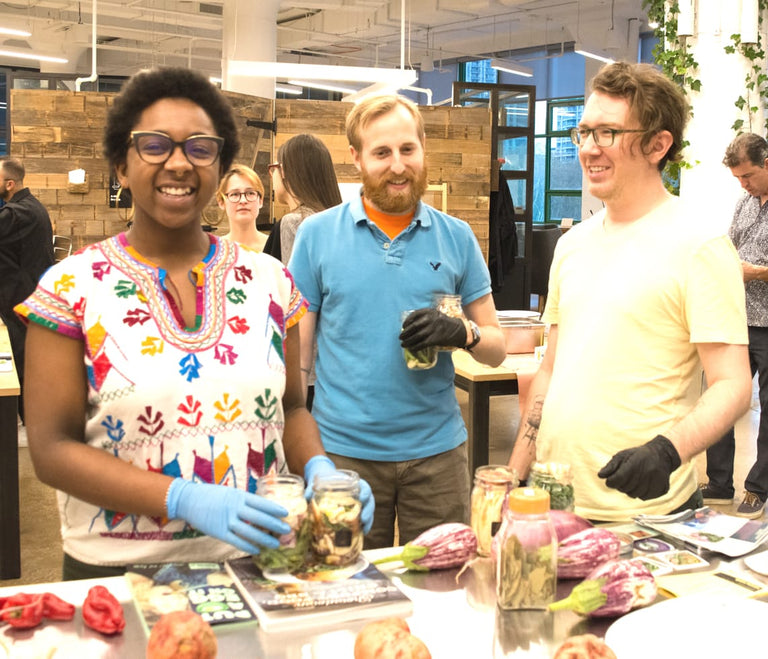Already Delicious
By Jessica Kulick, Local Roots subscriber + food lover
There was a time in my life—albeit, an admittedly palate-less and culinarily uneducated one—when I hated mushrooms. Absolutely abhored the stuff.  My parents would bring home what can only be described as a plastic-wrapped carton of tennis shoe leather, scorch them in a pan until at least one side had been utterly blackened, then unceremoniously plunk them on a plate next to an ordered-in dish of chicken parm and rigatoni slathered in red sauce. Don’t even ask me what was in my father’s “Spaghetti Surprise.” (Corn. It was canned corn. In a bolognese sauce. I shudder to this day.)
My parents would bring home what can only be described as a plastic-wrapped carton of tennis shoe leather, scorch them in a pan until at least one side had been utterly blackened, then unceremoniously plunk them on a plate next to an ordered-in dish of chicken parm and rigatoni slathered in red sauce. Don’t even ask me what was in my father’s “Spaghetti Surprise.” (Corn. It was canned corn. In a bolognese sauce. I shudder to this day.)
This is not to say that all of my teenage and childhood years were filled with tasteless produce and bewildering recipes. Dad had a knack for nailing the perfect brunch spread, Mom religiously took us apple-picking every fall, and both of my grandmothers were quite skilled in the kitchen, and it was from them I learned all manner of tips and tricks, like the right proportions of sweetness versus savoriness in a stuffing, or how to scrape crunchy rice off a pan before it burns and becomes inedible.
But still, I hated mushrooms. Tomatoes, too. See, I had only ever tasted the store-bought, wrapped-in-plastic, identical-pack-of-three kind. Were they uniformly bright red and round, with cute little leafy bits atop their shiny, bulbous bodies? Yes. Were they also mealy, flavorless, waxy orbs that I learned to be highly suspicious of? Also yes.
It wasn’t until a semester spent in France that I learned what it meant for food to be flavorful and the importance of terroir, those particular environmental factors that make for good food (and wine). Those daily markets were bursting with gorgeous produce of every variety, and puveyors were only too happy to let a curious American have a taste...of everything.
And taste I did. Breads, cheeses, charcuterie, vegetables, fruits—at one point I remember thinking that if I had never tasted a strawberry before, those French strawberries were what I would have hoped one might taste like.
So when I arrived back to the States, I dutifully purchased the organic (if expensive) produce for the upgrade in flavor alone, a routine I took to for years.
But then I found Local Roots.
At the time, I reported daily to an office above a coworking space. I noticed a sign advertising their subscription farm shares, and found that they’d deliver directly to us if we just got enough people to sign up.
That day I ditched all other duties, and made it my business to enlist as many colleagues as I could to sign up so that I could, selfishly, get more delicious food without having to go shop for it.
Luckily, I was successful. And sure enough, we were rapturous each week. The freshness of the eggs! The juiciness of the peaches! The brightness of the string beans! The mustardyness of the mustard greens! And my god, the cheese.
I don’t work at that office anymore, but I’ve never gone back to store-bought produce. It doesn’t matter how organic, farm fresh, and non-GMO that bag of corner store kale says it is, it probably traveled over a thousand miles just to get to my neighborhood and probably lost most of its flavonoids in the process.
What the hell are those, I’m sure you’re thinking. And also: why should I care?
Flavonoids are what provide fruits and veggies (and tea and wine!) with actual flavor, as the name suggests. They’re also anti-inflammatory, anti-carcinogenic, anti-oxidative, and anti-mutagenic. (Read: they’re good for you.)
Local Roots farmers understand this inherently. George Brittenburg, of Taproot Farm in Pennsylvania, says that “Plants are a reflection of what’s happening underground...so healthy soil encourages a plant to do the best it can. The farmer’s primary focus is the quality of the soil. When working towards improving the soil, there are no shortcuts. It requires constant nurturing, soil tests, and a balance of science and intuition.”
It’s a simple formula, really: more nutrient-rich soil makes for healthier plants, healthier plants have more available sugars, and more available sugars make for better, more satisfying flavor.
This balance of both science and intuition, I think, is what truly sets food from a Local Roots producer apart. It’s the farmer’s personal touch, their special blend of research and knowledge, testing and tasting that gives radishes their spicy kick, or beets their earthy sweetness, or cheese its creamy tang.
These types of revelations abounded at the recent Immersive Tasting Event. A few friends and I hopped over to East Williamsburg early Saturday afternoon, only to find ourselves waiting on the sidewalk along with dozens of other food-lovin’ New Yorkers to...taste produce?
That’s right. We were there to nosh on radish, to nibble on kale, and to sample apple from Wilklow Orchards, the very same farm my mother has taken me every September for years. As we perused the gallery of produce, one friend remarked how surprising it was to realize that most vegetables take an average of 144 hours to get from farm to grocery store, and that’s before you purchase it and deposit in your refrigerator for who knows how long.
Compare that to Local Roots growers, who are all within two hours of New York City, which means that their food is fresher, tastier, healthier—and has the added benefit of cutting down on unnecessary gas mileage.
We cruised from table to table, snacking on carrots and admiring the many beautiful colors and textures of nature’s wares. The Concord grapes in particular were of such a rich indigo that it seemed we were tasting the depth of the pigment along with their ripe, jammy sweetness.
And then there were the mushroom stems. They sat alone on a platter, totally free of seasoning or alteration of any kind.
Now, as an adult, I have learned to like mushrooms, even to the point where I now receive—and get excited for—my bimonthly share from Primordia Farms. Fungi are just plain interesting. There are so many varieties beyond the standard plastic pack of white button mushrooms that are ubiquitous to every grocery store across the land. There’s hen-of-the-woods and golden oyster and the especially strange lion’s mane breed, which remind me very much of those shaggy white dogs that look like mops.
Mushrooms, aside from their potentially psychoactive properties, just seem magical, otherwordly. Primordia’s head farmer Matt Sicher points out that every variety they grow can be classified as a culinary or medicinal, which is music to this Millennial’s ears because healthcare in this country is expensive and I’ll take all the immune-boosters I can get.

As we gathered ourselves to head back out into the Brooklyn sunshine, I felt a rush of gratitude for the quality of food available to me through the Local Roots farmers. Their food has the kind of undulating character that reveals itself not only in the first bite but also in the second and the third and the last, that lingers like the impression after a really good date. It reminds at least this home cook that adding sauces and condiments and spice after spice to any one dish is mostly unnecessary—as long as the ingredients you start with are fresh and already delicious.
Rather have a taste first?
Local Roots Experiences are fun, pop-up events where we bring the farm to you!

Become a Harvest Club Pick Up Location
Are you a NY based cafe, bar, or neighborhood business? Become a Harvest Club pick up location and have community members come to your establishment each week to pick up their Local Roots harvest.
Top








